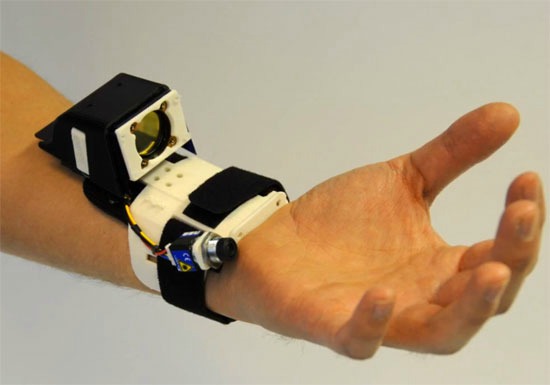Turning Your Hand Into a Remote Control
A Microsoft prototype called Digits could put the power to control everything from TV screens to smart phones in a device you wear on your wrist
![]()

Digits takes motion control to a new level. Photo courtesy of Microsoft Research
Yes, Microsoft rolled out Windows 8 yesterday and yes, it’s the company’s biggest high-stakes launch in a long time and yes, it’s its first real plunge into the world of tablets and smart phones. Plenty of others are already covering that ground. I’d rather talk about a little device Microsoft unveiled earlier this month, something far lower on the hoopla scale.
It’s called Digits and it’s one special bracelet. But this is not some flashy bangle that dangles; this is a wrist sensor capable of turning your hand into a control unit.
Created by a team of Microsoft researchers in Great Britain, Digits uses sensors and an infrared camera to put a little Kinect device on your wrist. But the key is that it’s not tethered to a game system, plus it’s focused entirely on your hand and anything you do with it.
Motion slickness
Digits is the latest thing in motion control, tech that creates a 3D model of your hand in real time, allowing you to point to items or content on a screen rather than moving a cursor around with a mouse. Or it could, as some think, evolve into the device that ultimately replaces the TV remote.
As David Kim, one of its inventors, explains: “People can interact while moving from room to room or running down the street. This finally takes 3D interaction outside the living room.”
Now you may ask, “What are you going to do with a wrist-mounted sensor when you’re running down the street?” This is a good question. Not sure if even anyone at Microsoft could give you a good answer. The point is that this is a device that goes with you, a virtual controller that one day could allow you to interact with any number of screens–whether it’s to control a TV or dial phone numbers or play video games.
For now, it’s a clunky thing--Steve Jobs would never have permitted the public even a glimpse of something so devoid of sleekness. But Digits is much more about function than form. It’s still a prototype, one whose focus is more about working well than looking good. Eventually, though, Microsoft hopes to be able to scale it down to something that looks and feels more like a watch.
And maybe then we’ll be able to take the bold step of losing the TV remote with forethought, and perhaps a little malice.
It’s a control thing
Here are other recent developments in how we control all the devices in our lives:
- That sweeping sensation: A Japanese company is developing a tiny infrared sensor that will allow you to swipe or zoom content on a computer or a smart phone without touching the screen. All it would take is a sweep of your hand to turn a page.
- But will it understand a stationary middle finger?: Also in Japan, Pioneer has started selling GPS units that you can control with hand gestures as you drive. Horizontal hand waves can be assigned to do 10 different things on the unit embedded in the dashboard.
- It’s all on your head: Motorola has released a head-mounted wearable computer for people who need to keep their hands free while working. The device’s gyroscope, accelerometer and digital compass allow a user to scroll, pan, tilt, zoom and freeze documents or schematics with a simple turn of the head.
- Is this the end of chocolate-covered touch screens?: Qualcomm has come out with a processor that makes it possible to flip pages on a tablet through gestures only. It’s been demoed as a way to play games or read recipes without having to touch the screen.
- A signature moment: Apple, meanwhile, has a patent pending on a process that will allow you to write a much more precise version of your signature with your finger on the screen of a device.
- When cars flirt: Last week Toyota unveiled a teeny-tiny electric car called the Insect. To help a person get past any reservations about riding inside something called an Insect, the vehicle uses Kinect sensors to recognize the driver and unlocks the doors when it sees him or her wave. It also blinks hello with its headlights.
- Because moving your fingers can be such a waste of energy: Sony is developing technology that would make it possible for someone to control a game using only their gaze and, eventually, only their brain waves.
- Riding the wave: As part of its campaign to show how hand gestures can be incorporated into the operation of vehicles, Toyota has created a skateboard for which the rider can change speeds by moving his hands.
Video bonus: Still not sure how Digits is supposed to work? Here’s Microsoft’s video explainer.
More from Smithsonian.com
/https://tf-cmsv2-smithsonianmag-media.s3.amazonaws.com/accounts/headshot/randy-rieland-240.png)
/https://tf-cmsv2-smithsonianmag-media.s3.amazonaws.com/accounts/headshot/randy-rieland-240.png)